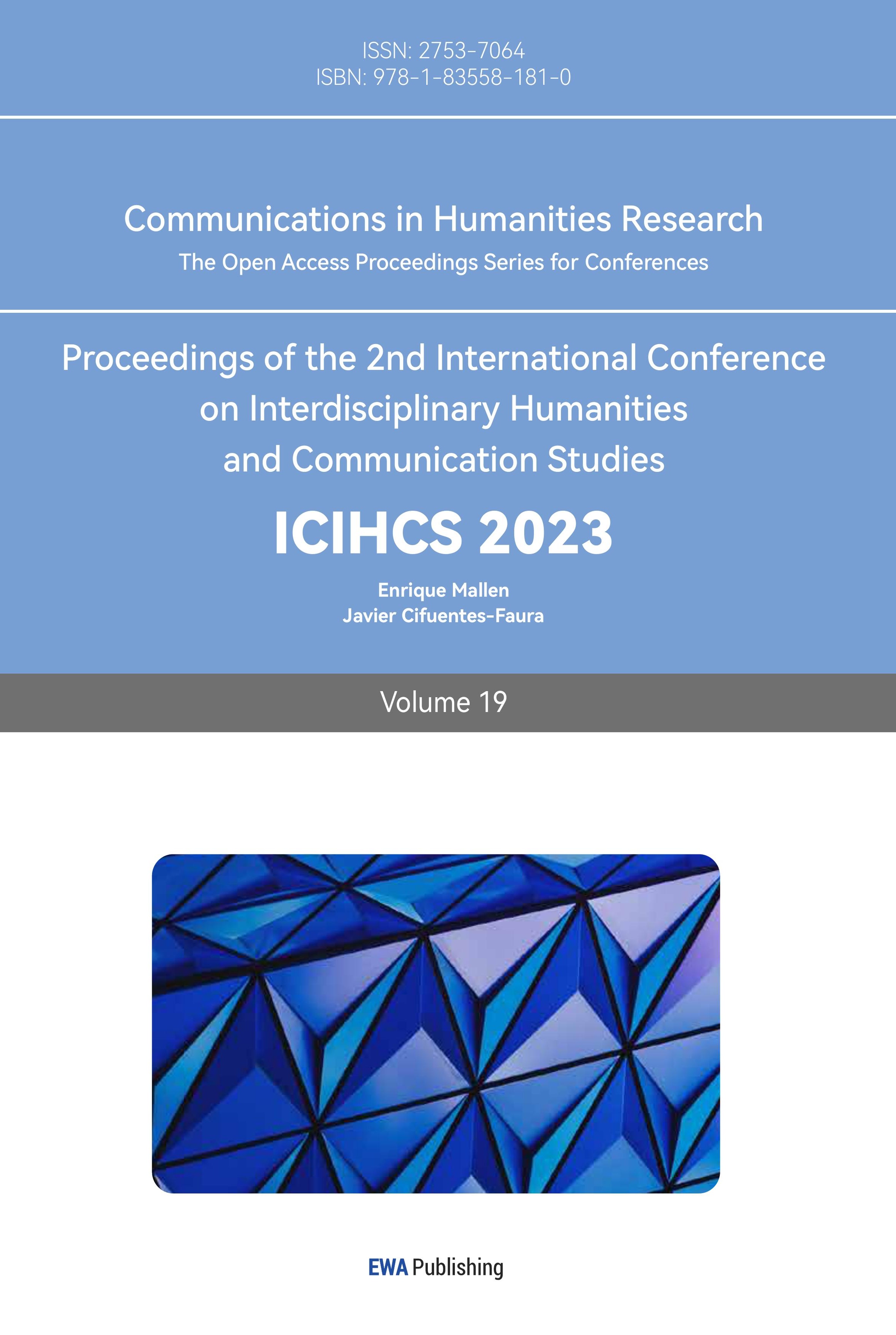1.Introduction
In recent years, it is precisely because of the impact of globalization that people from all over the world are using the same social media platforms, including YouTube, Instagram, and TikTok, which allows everyone to see the dynamics of their own country but also interested in the daily life shared by people in other countries. Research on the communication effect of traditional Chinese culture on social media is divided into Chinese characters, architecture, music, literature, food, and philosophy [1]. Among them, as one of the essential cultures exported by China, the popularity of Hanfu has risen thanks to social media platforms, where fans and advocates of Hanfu have created a vibrant online community. Hanfu has become a symbol of Chinese cultural identity and heritage with its elegant designs, intricate embroidery, and rich cultural symbols [2].
Regarding the marketing strategy of Hanfu, conducted a detailed investigation of a Chinese manufacturer that sells Hanfu to the world [3]. Taking the public opinion event of the traditional clothing culture dispute between China and South Korea in November 2020 as an example, the reasons and countermeasures for the cross-cultural conflict between China and South Korea were analyzed and resolved [4]. The research found that previous research has yet to be a detailed discussion and research on the promotion and inheritance of Chinese Hanfu culture on social media platforms and the effectiveness of cross-cultural communication. On Google, the world’s largest portal website, it was found that Hanfu accounted for a large proportion of videos related to Chinese culture, with 2,390,000 videos. From the data point of view, the information contained in Hanfu is sufficient and more accurate. The larger the sample size, the higher the reliability [5]. Based on the research mentioned above findings, it is evident that there needs to be more detailed discussion and research on the promotion and inheritance of Chinese Hanfu culture on social media platforms and the effectiveness of cross-cultural communication. This presents an opportunity for further exploration and understanding of the impact of Chinese culture dissemination, explicitly focusing on the dissemination of Hanfu on international social media. Given these insights, this paper seeks to delve into the dissemination of Hanfu on social media as a representative example, aiming to explore the broader effect of Chinese culture dissemination on international social media platforms. Doing so aims to contribute to a better understanding of cross-cultural communication and the promotion of Chinese culture in the digital age.
Therefore, this paper explores the communication effect of Hanfu on international social media by analyzing the video content, viewing volume, comments, and other data of Hanfu on YouTube. This paper uses a combination of case study and content analysis to first analyze the dissemination effect of Chinese Hanbok culture by counting the number of views, likes, and comments on Hanbok videos.
This paper aims to study the dissemination effect of Chinese culture on international social media, taking the dissemination of Hanfu on YouTube as an example. Analyzing the phenomenon of Hanbok communication on YouTube explores Chinese culture’s influence and audience response on international social media platforms and the challenges and opportunities that may be encountered in the communication process.
This paper focuses on the dissemination effect of Chinese culture on international social media and analyses the dissemination of Chinese dress on YouTube as an example. The communication effect of Chinese clothing on global social media is explored by analyzing the content, viewership, comments, and other data of Chinese dress videos. The phenomenon of Chinese dress communication on YouTube is studied to investigate Chinese culture’s influence and audience response on global social media platforms and the challenges and opportunities that may be encountered in the communication process. The study highlights the dominance of individual accounts in Hanfu content, the limited public participation, and the positive and emotionally resonant nature of viewer comments on Hanfu videos. Promoting Chinese dress videos on YouTube can effectively reach a broad audience and maintain a balanced and positive image. At the same time, studying the spread of Chinese dress on YouTube can also provide reference and inspiration for developing other cultural forms on international social media. In conclusion, by studying the communication effects of Hanfu on YouTube, this study aims to explore the status and influence of Chinese culture on international social media.
2.Method
Before experimentally analyzing the data, it was first necessary to choose a framework for assessing communication effectiveness to illustrate better whether the research participants would achieve the desired results. A literature reading was conducted to synthesize and utilize the relationship between social media and audience communication [6].
Fishbein and Ajzen’s Theory of Communication Effectiveness describes the relationship between beliefs, attitudes, intentions, and behaviors and the impact of communication activities on these factors [7]. Focusing on the effects of communication activities on audience behavior and attitudes can be used to assess the effectiveness of social media communication strategies. It is possible to analyze what specific audience groups of media platforms behave in a way that gives an idea of whether the communication strategies of these platforms can achieve the desired results, as well as the audience’s reactions and behaviors. Liang and Lee combined the use and gratification theory and dependency theory. They found that social media participation is closely related to an individual’s social connection, information acquisition, entertainment, and self-expression [8]. The purpose of social media use and individual satisfaction significantly affect social media participation, and the degree of personal dependence on social media is also positively related to participation. Wang’s study reveals the communication path and influence of social media advertising by analyzing the elements of source, message, medium, audience, and effect [9]. The research results show that social media advertisements’ source and message content significantly impact the audience’s attitude and purchase intention, and the media choice and audience characteristics also play a vital role in the advertisement dissemination effect.
Synthesizing the above literature and research findings, this paper will be based on the characteristics of two-way communication feedback and the importance of targeting specific audiences. The Defleur Model of Mass Communication System evaluates social media communication’s effectiveness. The model includes the elements of source, message, medium, audience, and effect [10]. The framework can help researchers analyze social media communication’s effectiveness and evaluate whether the communication strategy achieves the expected results. The model of mass communication expands on the Shannon & Weaver model by introducing mass media communication strategies to achieve the desired results. Weaver’s model introduces the mass media device and emphasizes the circular nature of communication with two-way feedback [11]. In modern social media, participants are both senders and receivers of information. The same person can play different roles. The framework can help this paper analyze social media communication’s effectiveness and evaluate whether the communication strategy achieves the expected results.
In this model, the reference refers to the initiator of Chinese cultural propaganda abroad, the statement relates to the content of communication, the medium YouTuBe refers to the channel of communication, the audience relates to the group of people who receive the message of communication, and the effect refers to the influence produced by contact. By studying the interrelationships between these elements, the impact of China’s Hanbok culture on foreign propaganda can be better understood. Therefore, this paper uses the “Defleur Model of Mass Communication System” to determine whether the viewership data, number of likes, and number of comments exist. The research object mentioned in the Introduction, firstly, through the viewership of the Hanboks, whether the international users have widely noticed it or not. Secondly, through the emotional performance of the audience users, to find out the value of their feedback, and finally, through the account of the video posting to see whether it is diversified. Through the analyses, we explore the influence of Chinese dress on international social media and the possibility of cultural transmission.
This paper takes Chinese traditional dress hanbok videos on YouTube, the world’s largest video-sharing website, as the research object. The theories involved in the research program are combined with communication science as well as the double-cycle model of mass communication and through the quantitative analysis of the three dimensions of video posting account, video posting content, and video viewers, combined with the qualitative analysis of the content of YouTube users’ video comments.
3.Experiment Results and Analysis
3.1.Programme Description
This paper uses YouTube’s search engine for the keyword “Hanfu.” The author grabbed data with Python and conducted a screening process on many videos within three years. A total of 318 videos were selected for data collection and analysis. The data was presented by examining the type of video release account, video release content, and video viewers (quantitative analysis), as well as the content of video comments (qualitative research). The data description focuses on three aspects: the viewing volume of Chinese dress videos, the comment section of Chinese dress videos, and the diverse channels of Chinese dress video dissemination. These aspects are used to describe the results of the study.
3.2.Presentation of Results
3.2.1.Case Studies (Video Posting Accounts)
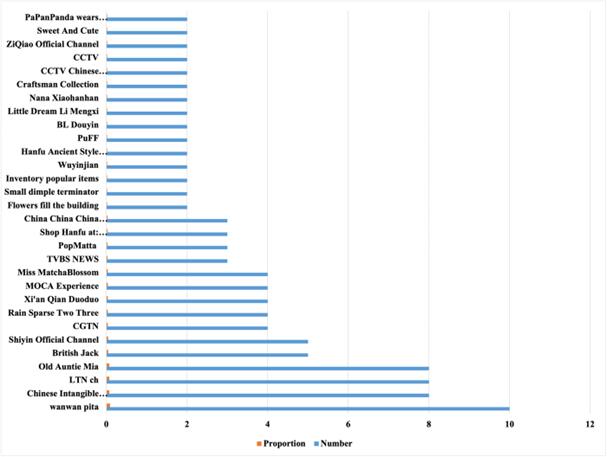
Figure 1: Ranking of the number of video accounts posted.
From Figure 1, YouTube Chinese costume content publishers are of various types, but there is a clear concentration trend, with individuals and media constituting the primary source of publishers. Regarding the number of Chinese costume videos posted by accounts, Chinese cultural associations and individual accounts of overseas Chinese are more active, posting a relatively large number of Chinese costume videos and updating them more frequently.
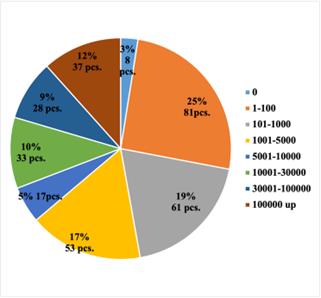
Figure 2: Number of subscriptions to the posted video account.
As shown in Figure 2, There are eight accounts with 0 subscriptions, accounting for 2.52% of the total. This indicates that a few funds in the studied Hanbok videos have low subscriptions or even 0. This may suggest that there are problems with these accounts’ content or promotional strategies, resulting in low subscriptions.
The number of accounts with subscriptions between 1 and 100 totaled 81, more than a quarter of the total. This indicates many accounts with low subscriptions in the Chinese dress videos. This may be due to the fierce competition and the difficulty in attracting viewers to subscribe, or the quality of content and promotional tactics of these accounts could be improved.
There are 37 accounts with more than 10,000 subscriptions, accounting for 11.64%: the number of accounts with a specific size of subscriptions is small compared to those with a lower number of subscriptions. This suggests that there are relatively few accounts with more significant subscriptions in Hanfu videos because more time and effort are needed to attract more viewers’ attention and subscriptions.
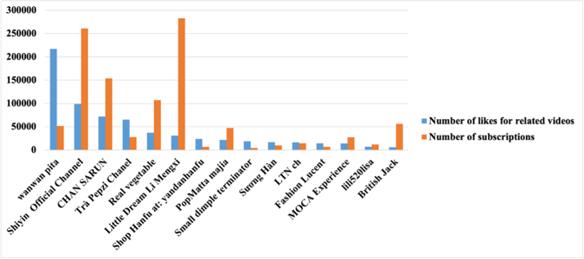
Figure 3: The number of publishers and likes of the video account.
As of the day of data collection, the top 15 publishers in terms of subscribers are shown in Figure 3. The personal account “Little Dream Li Mengxi” has the most significant number of subscribers, about 283,000. This indicates that this personal account has high popularity and influence in Chinese dress videos, attracting many subscribers. The individual bill “wan pita” has the most likes on the videos, with about 217,196 likes. This indicates that the videos posted by this account are highly recognized and liked by viewers. The increased number of likes means that viewers appreciate and support the content. Keeping up with current events is a big reason for being on the list.
The absence of Chinese media organizations among the top fifteen publishers can indicate that individual accounts have an advantage in attracting subscriptions and gaining likes in Hanfu videos. This may be related to personal accounts’ more flexible and personalized content creation and promotion approach.

Figure 4: Account Type Distribution.
Individuals and media constitute the primary sources of publishers. Regarding the number of accounts posting Chinese dress videos, Chinese cultural, social media organizations, and general personal video accounts have a high frequency of posting Chinese dress-related videos. This indicates that Hanfu has a certain degree of attention and popularity among individuals and media (Figure 4).
Professional media have a clear advantage in spreading Chinese dress: Although both individuals and media post-Chinese dress videos, the professional press have a clear advantage in spreading Chinese clothing. They provide higher-quality and professional content and may have more resources and expertise to dig deeper and present information about Hanfu.
3.2.2.Case Studies (Video Release Content)
The number of accounts with cumulative views of 10,000 or more is 110, accounting for nearly 40 percent of the total. This suggests that the number of accounts with higher views is relatively high in Chinese dress videos. These accounts’ content quality, promotion strategies, or other factors attracted more viewers, enabling their videos to receive more views.
There are only 25 accounts with view counts between 5,000 and 10,000, accounting for 8.33%: the number of accounts with views between 5,000 and 10,000 is low compared to versions with higher views. This may be because, in this viewership range, the funds need more buzz and are more competitive, making it more difficult to attract viewers. Besides, the data on video duration shows that longer-duration videos face less attention than hanbok videos. Viewers are more inclined to watch shorter-duration videos, while there may be a higher churn rate for longer-duration videos.
3.2.3.Case Studies (Video Release Time Distribution)
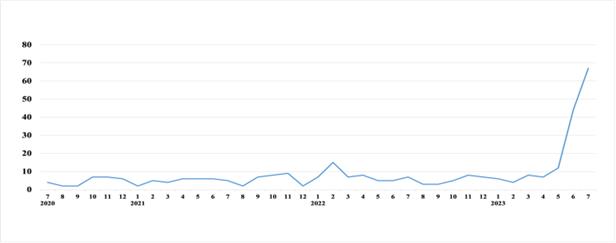
Figure 5: About the month.
Figure 5 shows that the number of Chinese dress videos posted on the YouTube platform has increased yearly: this shows that Chinese dress videos have gradually increased in popularity on the YouTube platform. This may be due to the increasing popularity and visibility of Chinese dress at home and abroad, which attracts more and more content creators to post related videos.
The number of Hanfu videos posted on the YouTube platform fluctuates differently between months, possibly because the popularity of Hanfu as a traditional Chinese art form fluctuates at different times. It may be related to specific festivals or other factors. This shows that people are paying more and more attention to cultural communication.
From October to December 2020, the number of video postings increased dramatically due to the costume events in China and South Korea, which suggests that the external event topic events could have aroused the public’s attention and discussion about Hanfu, which led to a sharp increase in the number of Hanfu videos posted.
3.2.4.Case Studies (Video Viewers)
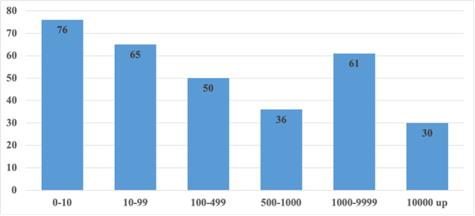
Figure 6: Distribution of video likes.
The distribution of likes of Hanfu videos on YouTube reflects the influence of cultural communication content on the audience’s emotions and attitudes, and the number of likes can reflect the degree of the audience’s love and recognition of Hanfu videos. By analyzing the distribution of the number of likes, it is possible to understand the audience’s emotions and attitudes toward Hanfu cultural communication content.
According to the data in Figure 6, among the 318 sample videos, those with less than ten likes account for the most significant proportion, while there are only 30 videos with more than 10,000 likes. This indicates that the overall public engagement with videos in the Hanfu domain regarding liking behavior is low. The performance of different videos in terms of the number of likes varies significantly. The uneven distribution of the number of likes may reflect the differences in viewers’ enjoyment and recognition of different video content.

Figure 7: Distribution of the number of video comments.
As shown in Figure 7, among the 318 sampled videos, videos with less than ten comments accounted for nearly half the total. Only 2% of the above 10,000. It shows that the public’s overall participation in the behavior of likes and dislikes of Hanfu is low. There are significant differences in the performance of different videos regarding likes and dislikes. The same as Figure 6 shows that the overall participation of the public in commenting on the field of view of Hanfu is low. The performance of different videos in comments varies significantly.
3.2.5.Content Research
The audience’s feedback words are relatively positive by analyzing the keywords and capturing them (Figure 8). However, it is worth noting that the audience is much more interested in political and economic topics than in general Hanfu propaganda.
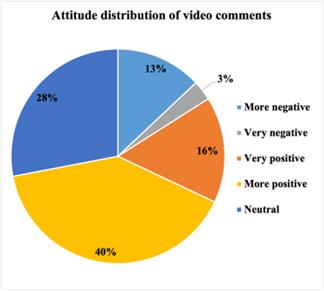
Figure 8: Video comment attitude distribution.
The differentiation of user comments is more evident because the polarization of words also occurs under the same video.
It also found that the comments on video reviews of topics touching on current events are more emotional, especially in the controversy about Chinese and Korean clothing, the differentiation of comment attitudes is slightly more prominent.
3.3.Description of Experimental Results
In the number of views of Hanbok videos, it was found that. From the ranking of the number of accounts posting videos, there is a relatively high percentage of topics about Hanfu in individual accounts. From the study of subscription data in the field of Hanbok videos, there are some accounts with low subscriptions, while the number of accounts with high subscriptions is relatively minimal. From the ranking of the number of subscriptions, the number of likes, and account type distribution, individual accounts have an advantage in attracting subscriptions and gaining likes in Chinese dress videos. However, media organizations could be more robust in this area.
From the research on the content of the video release, the number of video views can reflect the degree of attention of the Hanfu video on social media platforms within a certain period. The larger the number of video views, the higher the degree of awareness of this video and the broader the scope of dissemination. From the perspective of the year and month of the video release, combined with the analysis of the release account, both official and personal accounts have a significant upward trend in the number of outs.
The study of video viewers shows that the public’s participation in Hanfu culture dissemination on YouTube could be much higher. Nearly half of the videos have a single-digit number of comments, and a few popular videos have a high number of words. Especially when it comes to controversial topics, everyone discusses more intensely, but most of the videos get less than ten comments. Although the percentage of video likes is evenly distributed, it shows that the overall participation of the public in the likes of Hanfu videos is low. Different types of videos have significant differences in the number of likes.
In examining the data on user comments, the author found that polarization of words may occur under the same video. Generally, comments on hanbok videos on YouTube are more emotional, and differences in comment attitudes are more prominent. However, there are no extreme statements in the comments. Notably, according to the word cloud analysis, the comments are entirely unrelated to political views, and the overall attitude of the remarks is relatively positive. These observations suggest that viewers’ comments and attitudes towards the hanbok videos varied but were overall positive. The emotional nature of the words may reflect the viewers’ emotional connection and resonance with Chinese dress. The lack of extreme words may indicate that promoting Chinese dress videos on YouTube is more balanced and neutral, without provoking too much controversy or less controversy.
Through quantitative analysis of statistical data and qualitative analysis of user comments, This paper finds the advantages and disadvantages of promoting Chinese dress on YouTube. Based on the three dimensions of communication, information publisher, content, and audience, YouTube communication has the following characteristics: firstly, YouTube is an open platform; anyone can be the information publisher, increasing the diversity of information and the breadth of sources. Second, the communication content on YouTube is rich and diverse, including videos, comments, and likes, which makes communication more diversified and interactive. Finally, YouTube has a large global audience that can reach a wider audience and increase the promotion effect and influence.
4.Discussion
This paper leverages media expertise to create unique cultural content showcasing the personality and charm of Chinese culture. It focuses on utilizing hot events to spread Chinese culture, delving deeper into its essence, and disseminating high-quality content.
The results suggest the effective utilization of local communities and collaboration with them to enhance interaction. Emphasizing emotional communication in interactive exchanges and engaging with audiences enhances their sense of identification with Chinese culture.
This result recommends using various social media accounts to target specific audience segments based on their attributes and interests. Providing more accurate content attracts greater attention and encourages active participation. Presenting the symbolic connotation of Chinese cultural communication from multiple perspectives enables audiences to understand Chinese culture through diverse forms of content display comprehensively.
The findings of this experiment align with theoretical support, effectively reflecting the current state of cultural communication through social media data. The researchers also discovered that foreigners often confuse Chinese Hanfu with Korean Hanfu, leading to significant attention received by related videos.
While the countermeasures and suggestions provided in this paper offer a relatively comprehensive approach to enhance the international dissemination of Chinese culture through social media, it is essential to note that the network environment is constantly evolving, and technological advancements are continually progressing. So, these countermeasures and suggestions should be quickly adjusted and revised to accommodate any changes that may impact the dissemination of Chinese culture on international social media platforms [12].
5.Conclusion
This paper reveals how Chinese culture is promoted on international social media by profoundly analyzing the spread of Hanbok on YouTube. As one of the representatives of traditional Chinese culture, promoting Hanbok on global social media has facilitated the dissemination of Chinese culture and positively affected international users’ cultural awareness and cross-cultural communication. Future research can further explore the communication effects of other Chinese cultures on global social media and how to use social media platforms better to promote Chinese culture. Based on the perspective of cultural communication effects, this paper summarises the status of international social media communication effects on Chinese art. The evaluation index system of YouTube’s marketing communication effect is constructed. Taking Chinese dress communication on YouTube as an example, quantitative and qualitative empirical analyses are applied to evaluate the communication effect of Chinese Chinese dress on the YouTube platform. Then, the optimization strategy of Chinese culture’s international social media marketing communication is proposed.
It is found that Chinese costumes are differentiated and diversified on YouTube. However, there are some accounts with low subscriptions. In contrast, the number of accounts with high subscriptions is relatively tiny, requiring further research and improvement in content quality and promotion strategies, such as focusing on the driving effect of hot events and cultivating high-quality communication content to increase the number of subscriptions and influence of accounts. Individual accounts have a particular advantage in attracting subscriptions and gaining likes because of their content quality, promotion strategy, or personal charisma. However, Chinese media organizations could be more robust in this area, so international social media communication of Chinese culture needs to take advantage of media strengths to create personalized cultural content. Secondly, viewers are more inclined to watch shorter-length videos, while there may be a higher churn rate for longer-length videos; therefore, content creators should keep a simple and concise style when producing Chinese costume videos to attract viewers’ attention and sustain viewing. As for sentiment analysis, the suggestion is to optimize the promotion strategy of Chinese dress videos. For example, more emphasis can be placed on emotional resonance and connection to attract viewers’ attention and participation through video content and storytelling presentations. At the same time, it is also possible to continue to maintain a neutral and balanced attitude to avoid triggering too much controversy to ensure a better promotion of Chinese dress videos on YouTube, strengthen emotional communication in interactive rituals, and enhance the sense of identity of Chinese culture; present the symbolic connotations of Chinese cultural communication from multiple perspectives, and segment audience attributes in a complementary way with different accounts. Thus, the communication effect of Chinese culture on international social media can be comprehensively enhanced, and the process of Chinese culture “going out” can be accelerated.
The result of this paper is the result of gaining an in-depth understanding of the communication effect of Chinese culture on international social media. It provides a reference for the promotion and inheritance of Chinese culture. At the same time, studying Hanbok’s communication on global social media can reveal its impact and influence on cultural transmission and provide reference and inspiration for the information of other cultures.
References
[1]. Wang, X., Colbert, F., & Legoux, R. (2020). From niche interest to fashion trend: Hanfu clothing as a rising industry in China. International Journal of Arts Management, 23(1), 79-89.
[2]. Guo, W. (2020). Hanfu: A Study on the Revival of Traditional Chinese Clothing. In Cultural Perspectives on Dress, Body, and Identity (pp. 237-256). Springer.
[3]. Zhang, C., & Gong, T. (2023). The brand strategy and cross-border promotion of Han Chinese clothing under the digital economy. Electronic Commerce Research, 23(1), 257-277.
[4]. Chaohong, W., & Yajun, L. (2021, June 10). Discussion on the competition between Chinese and South Korean traditional clothing culture in cross - cultural communication. Discussion on the Competition Between Chinese and South Korean Traditional Clothing Culture in Cross - Cultural Communication | Atlantis Press. https://www.atlantis-press.com/proceedings/iclace-21/125957571
[5]. Charlesworth Author Services.(2022)The importance of having large sample sizes for your research The importance of large sample sizes in research | CW Authors. Available at: https://www.cwauthors.com/article/importance-of-having-large-sample-sizes-for-research.
[6]. Derya GÜL ÜNLÜ; “Evaluation of Digital Media Usage of Women Through Motherhood Models As A Cultural Ideology”, 2019.
[7]. Fishbein, M., & Ajzen, I. (1975). Belief, attitude, intention, and behavior: An introduction to theory and research. Addison-Wesley.
[8]. Liang, Y., & Lee, J. (2018). Understanding social media engagement: A model integrating uses and gratifications theory and the dependency theory. Computers in Human Behavior, 80, 236-244.
[9]. Wang, Y., & Sun, S. (2010). The impact of online word-of-mouth on consumer purchase intentions: A model of information adoption in online communities. Journal of Interactive Marketing, 24(2), 21-34.
[10]. DeFleur, M. L., & Ball-Rokeach, S. J. (1989). Theories of mass communication. Longman Publishing Group.
[11]. Mulyana, D. (2007). Ilmu Komunikasi: Suatu Pengantar. Bandung: PT. Remaja Rosdakarya, p.165
[12]. Bing He; “Exploration on The Building of Golden Course Under The Background of “Culture Export”“, 2020 INTERNATIONAL CONFERENCE ON EDUCATIONAL SCIENCE ..., 2020.
Cite this article
Zou,Q. (2023). Research on the Effect of Cross-Cultural Communication of Chinese Culture on YouTube ——Evidence from Hanfu. Communications in Humanities Research,19,96-107.
Data availability
The datasets used and/or analyzed during the current study will be available from the authors upon reasonable request.
Disclaimer/Publisher's Note
The statements, opinions and data contained in all publications are solely those of the individual author(s) and contributor(s) and not of EWA Publishing and/or the editor(s). EWA Publishing and/or the editor(s) disclaim responsibility for any injury to people or property resulting from any ideas, methods, instructions or products referred to in the content.
About volume
Volume title: Proceedings of the 2nd International Conference on Interdisciplinary Humanities and Communication Studies
© 2024 by the author(s). Licensee EWA Publishing, Oxford, UK. This article is an open access article distributed under the terms and
conditions of the Creative Commons Attribution (CC BY) license. Authors who
publish this series agree to the following terms:
1. Authors retain copyright and grant the series right of first publication with the work simultaneously licensed under a Creative Commons
Attribution License that allows others to share the work with an acknowledgment of the work's authorship and initial publication in this
series.
2. Authors are able to enter into separate, additional contractual arrangements for the non-exclusive distribution of the series's published
version of the work (e.g., post it to an institutional repository or publish it in a book), with an acknowledgment of its initial
publication in this series.
3. Authors are permitted and encouraged to post their work online (e.g., in institutional repositories or on their website) prior to and
during the submission process, as it can lead to productive exchanges, as well as earlier and greater citation of published work (See
Open access policy for details).
References
[1]. Wang, X., Colbert, F., & Legoux, R. (2020). From niche interest to fashion trend: Hanfu clothing as a rising industry in China. International Journal of Arts Management, 23(1), 79-89.
[2]. Guo, W. (2020). Hanfu: A Study on the Revival of Traditional Chinese Clothing. In Cultural Perspectives on Dress, Body, and Identity (pp. 237-256). Springer.
[3]. Zhang, C., & Gong, T. (2023). The brand strategy and cross-border promotion of Han Chinese clothing under the digital economy. Electronic Commerce Research, 23(1), 257-277.
[4]. Chaohong, W., & Yajun, L. (2021, June 10). Discussion on the competition between Chinese and South Korean traditional clothing culture in cross - cultural communication. Discussion on the Competition Between Chinese and South Korean Traditional Clothing Culture in Cross - Cultural Communication | Atlantis Press. https://www.atlantis-press.com/proceedings/iclace-21/125957571
[5]. Charlesworth Author Services.(2022)The importance of having large sample sizes for your research The importance of large sample sizes in research | CW Authors. Available at: https://www.cwauthors.com/article/importance-of-having-large-sample-sizes-for-research.
[6]. Derya GÜL ÜNLÜ; “Evaluation of Digital Media Usage of Women Through Motherhood Models As A Cultural Ideology”, 2019.
[7]. Fishbein, M., & Ajzen, I. (1975). Belief, attitude, intention, and behavior: An introduction to theory and research. Addison-Wesley.
[8]. Liang, Y., & Lee, J. (2018). Understanding social media engagement: A model integrating uses and gratifications theory and the dependency theory. Computers in Human Behavior, 80, 236-244.
[9]. Wang, Y., & Sun, S. (2010). The impact of online word-of-mouth on consumer purchase intentions: A model of information adoption in online communities. Journal of Interactive Marketing, 24(2), 21-34.
[10]. DeFleur, M. L., & Ball-Rokeach, S. J. (1989). Theories of mass communication. Longman Publishing Group.
[11]. Mulyana, D. (2007). Ilmu Komunikasi: Suatu Pengantar. Bandung: PT. Remaja Rosdakarya, p.165
[12]. Bing He; “Exploration on The Building of Golden Course Under The Background of “Culture Export”“, 2020 INTERNATIONAL CONFERENCE ON EDUCATIONAL SCIENCE ..., 2020.





